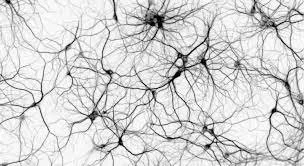What is Primary Chronic Pain?
Animation of neural networks firing in the brain
Understanding Pain: A Simple Guide
Why Do We need Pain?
Pain is crucial for our survival. It is your brain’s way of protecting you. If you touch something hot, you feel pain, and you move your hand away to avoid getting hurt. If you break your arm, pain tells you to stop moving your arm and get help. Pain helps you stay safe and survive. When your brain senses danger, it signals pain in order to keep you safe.
Pain is your brain’s response to danger
As a way to think about pain, imagine that you have a personal alarm system inside your body, just like a fire alarm at home. This alarm's main job is to keep you safe. It's called "pain," and it's like your body's way of saying, "Hey, something's not right, pay attention!" Your brain is in charge of signaling this alarm.
Usually the alarm goes off for a very good reason. If you injure yourself or if you get sick, your brain sounds the alarm. It’s your body’s way of saying “Danger! We need help!” This type of pain is called “secondary pain”, because the pain is secondary to the damage that was done to the body. Types of secondary pain include broken bones, burns, pain caused by infection, and pain caused by other damage to the body.
In the case of secondary pain, your body is right to sound the alarm because damage is present.
Where Does Pain Come From?
The fascinating part that studies have recently uncovered is that all pain comes from your brain. When you hurt your toe, your brain senses the physical damage done to your toe, and it signals pain as a way to tell you, "Hey, check out your toe, something's wrong!" It's your brain’s way of signaling you to pay attention. However, sometimes the brain can make a mistake, and signal pain when there is no physical damage. This is because pain is not only caused by physical damage, but rather a complex interplay of biological (physiological factors), psychological (emotions, thoughts, behaviors), and social (sociocultural and environmental) factors that influence a person's pain experience. This is called the biopsychosocial model of pain.
Image by kjpargeter on Freepick
What is Primary Pain?
Sometimes, the body’s alarm system can get a little too sensitive. It goes off even when there's no real physical danger. It’s like if the fire alarm goes off because of a slight breeze, or if it interprets a tiny candle as a big fire. We call this "primary pain." It's like your alarm system getting a bit too jumpy, or going off for reasons that are not physically dangerous.
Image by rawpixel.com
Why Does Primary Pain Happen?
In some cases, your brain may misinterpret signals from your body as dangerous. It's like your brain has become overprotective and in trying to ensure your survival, it makes a mistake. It may sense emotional or environmental stress, and mistake that for physical damage. In addition, recent studies show that centers in the brain responsible for emotions overlap with regions of the brain that signal pain. In some cases, the brain can interpret emotional or psychological threat as a physical threat, and signal pain. This is because pain is a biopsychosocial phenomenon.
This doesn’t mean the pain is in your head— all pain is REAL pain! Brain scans have proven primary pain is real and it hurts just as much or even more than secondary pain. Just like a when the fire alarm goes off as a false alarm and it’s REALLY loud, your pain can be extremely intense, even if there is no structural cause.
Pain is more than just a physical sensation
Traditional views of pain, emphasizing solely physical damage as its cause, have proven to be incomplete. We now understand that pain is influenced by multiple factors, with physical injury often playing a minor role, especially in chronic pain. Imagine this scenario: you are sitting on a large rock in the woods with a sprained ankle, waiting for help. Suddenly, a bear emerges from the forest, charging towards you. In this moment, the imminent threat overrides your pain response entirely, allowing you to run away without feeling pain so that you can protect yourself. This example vividly illustrates the complexity of our pain system.
This complexity arises from our brain’s ability to integrate various factors to determine the experience of pain we should be feeling in any given moment. The brain is the ultimate command center, and it makes these decisions with the number one goal being to keep us alive. Recent research underscores this perspective, leading scientists to adopt a comprehensive "biopsychosocial" view of pain. This framework recognizes pain as a multifaceted interaction of biological, psychological, and social elements. Pain, therefore, extends beyond mere bodily injury or illness to encompass the intricacies of our mental and environmental states.
The Biopsychosocial model of pain describes pain as a dynamic integration of biological, psychological, and social factors that reciprocally influence one another.
The Good News: Primary Pain Can Be Reversed!
Just like your brain can learn things, your brain can also unlearn things. If your brain's alarm is too sensitive, we can help you retrain it. Think of it like turning down the volume on your alarm, or having someone come in and repair your alarm so that it no longer reacts to situations that aren’t dangerous.
How does pain become chronic?
Animation of neurons firing within the brain. Neurons that fire together wire together, and these neural networks can become stronger as the brain learns. The brain can form new neural networks that replace the old networks with repeated practice and persistence.
The brain is incredibly good at learning. Unfortunately, sometimes the brain can learn things that are not helpful. If you get an injury or encounter a stressful situation, your brain may generate pain to protect you. If this happens often, neurons that frequently fire together “wire together”, creating stronger connections or neural networks (as shown lighting up in the animation at the left).
Over time, these strengthened connections within the neural networks can lead to chronic pain, where the pain signals in the brain continue long after the injury or pain-inducing situation has resolved.
Your brain learns pain, but your brain can also unlearn pain. Pain Reprocessing Therapy creates new neural networks that that your brain interprets as safe, which replace the old pain-generating networks.

Summary: What you Need to Know
Pain is your body's alarm system.
Your brain is in charge of the alarm (the pain).
Pain helps keep you safe.
Secondary pain is when the alarm is absolutely right to go off, such as when you get hurt or sick.
Primary pain is when the alarm is too sensitive and goes off in the absence of structural damage. It's real pain, but can be fixed. Your brain can learn to be less sensitive.
Chronic pain can also arise when neural networks remain intact, even after healing.
Primary Pain is your brain’s way of trying to get your attention and keep you safe. The brain is responding to perceived danger, which may be biological, psychological, or environmental.
In order to turn down the pain, we need treat the brain, and show the brain that you are safe.

Your pain is REAL
When stating that pain is generated in the brain, it is NOT suggesting that the pain is “all in your head”. The pain you feel is undeniably real, as validated by numerous studies. If you’ve been present during a fire drill, you know that a false alarm is just as loud. In the same way, the pain you feel is real. The good news is that you can teach your brain to dial down the pain signals and effectively 'unlearn' pain using techniques including pain reprocessing therapy. Pain is our brain’s way to protect us, but sometimes our brains can become overprotective.
What leads our brain to signal pain in the absence of structural damage?
Cracking the Code of Chronic Pain:
Our brain's top priority is survival, not comfort. Our brain sends pain signals as a protective measure, in some cases even if there's no actual harm.
Drawing a Parallel between Chronic Pain and Vision:
Just as pain is generated in the brain, vision is also generated in the brain. Vision is a complex process by which the eyes capture light, convert it into electrical signals, and the brain interprets these signals to create the images we see. To construct vision, our brain integrates past experiences and sensory input to generate what we see. Optical illusions highlight the interpretive nature of our visual processing system. Optical illusions, using contrasting colors or patterns, create ambiguity in visual scenes. When faced with complex or unfamiliar stimuli, our brain relies on past experiences, expectations, and context to interpret what we see. However, optical illusions intentionally introduce conflicting or ambiguous elements, challenging our brain's usual processes.
Optical illusions: Our brain relies on past experiences, expectations, and context to interpret and create what we see. When faced with complex or unfamiliar stimuli, our brains can make a mistake.
These optical illusions reveal how our brain can make a mistake when past experiences lead to predictions that deviate from reality
Video: Optical Illusions (Part 1)
The dynamic nature of pain
Video: Optical Illusions (Part 2)
Just as with vision, chronic pain is influenced by expectations, emotional and psychological elements, past experiences, and context. This can result in our brain making a mistake, and producing sensations that deviate from reality, including pain in the absence of structural damage.
Would you like to learn more about the brain and how it makes predictions based on past experiences, current situations, and many other factors? Stay tuned for more information and resources coming soon!
The Good News: You can break free from chronic pain
Pain Reprocessing Therapy is a new treatment approach that allows you to ‘unlearn’ chronic pain. This approach uses a unique combination of cognitive, somatic, and exposure-based techniques supporting pain reappraisal. Through this, your brain will learn to signal differently.
Our mission is to help you to understand what might be causing your pain, and most importantly, help train your brain to respond differently and dial down your pain. Learn more here.






